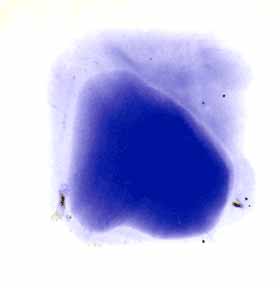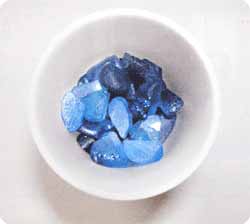|
The international Colored Gemstone
Association (ICA) has issued its first ICA Lab Report for 2004,
in which it informed germologists and members of the colored stone
trade about the findings of two of the world's leading gemological
laboratories--SSEF - Swiss Gemological Institute of basel,Switzerland,and
Gemological Institute of America-- which concured that,thus far,they
had found no evidence of diffision in batch of heated blue Sri Lanka
sapphires the were heat treated by the same source. this followed
recent report in the trade media,in which it was suggested that
a new heating process for blue sapphire from Sri Lanka may involve
"lattice diffision."
ICA's president,Joseph M. Menzie,explained
that the ICA Lab Alerts were developed to inform the trade, the
international gemological comunity, the media and tyhe public at
large of any developments related tom the discovery, detection and
identification of treatment and enchancements of natural of gemstone,
synthetic gemstones and gemstone simulant.
" Our first responsiblity is to protect
the consumer, and as such protect our product and the relationship
with our buyers," he stated. "ICA has been very effective
in disseminating information about treatments and leads the gemstone
industry by advocating and adhering to a practical,easy-to-understand
disclosure system. This has already proven to be very effective,
such as in case of the beryllium diffused sapphire, that were coming
out of thailand,starting in 2001." In addition,Mr menzie said,
when an unwarranted alarm is raised, ICA also needs to act and inform."
In this most recent case,early report suggested that a new heating
process involved diffusion. Thus far , such charges have proven
unfounded, and, in fact, reasonable explainations have been put
forward to explain what is being observed," he started.
Date: January 15,2004
Subject: Heat treatment of blue sapphire from Sri Lanka
Source: ICA Gem Bureau
To : Gemological laboratories,independent gemologists, members of
the colored gemstone and jewelry industries and trade.
Latest research into heat-treated
Sri Lankan blue sapphire does not turn up any indication of diffusion
Two of world's leadiing gemological laboratories-SSEF-Swiss
Gemological Institute of Basel,Switzerland,and The Gemological institute
of America,of Carlbad,California,have both reported that they found
no evidence of diffusion in a batch of heat blue Sri Lankan sapphire
that were heat treat by the same source. This followed recent repodt
in the trade media ,in which it was suggested that a new heating
process for blue sapphire form Sri Lanka may involve"lattice
diffusion".
SSEF said that it had examined sapphires
from Sri Lanka, ranging from 4.56 carats to 11.11 carats. "
The stones were rather free of inclusion and showed a medium strong
saturate blue color.One sampledisplayed a distince blue color zone,whereby
all others showed a rather uniform color distribution with common
illumination. Under the microscope they showed features indicating
a heat treatment. However, when examined in an immersion cell,these
sapphires showed patially strange uneven colorless rims of about
one millimeter thick," SSEF wrote in its report. "Surprisingly,the
coloeless zone do not follow completely the outline of the cut stones.
Similar observations had already been communicated recently by Ken
Scarratt (AGTA Gem Tesing Center, New York,July 18,2003),"
the SSEF report continued. Was this anomaly due to a diffusion,
in which foreign elements were introduce into the chamber during
heating? if so, this could trigger a negative reaction similar to
the experienced with the beryllium diffusion-treated corundam in
2001 and 2002, SSEF noted.
But the SSEF report offered a pluasible
explanation for the phenomenon. It was based on analysee carried
out at the SSEF facilities, involving both standard and sophisticated
testing. The reason that only a few of the blue sapphire showeda
colorless rim,SSEF suggested ,was that a majority of the cases the
treatment was performed on rough stones. " Many rough sapphires
are first heated and then cut in order to take profit from a good
orientation of the shape.Should these heated rough stone produce
a colorless margin,it would partly be removed during shaping and
polishing .In our present case we are thus dealing with sapphire
which sustain parts of surface related fading zones," SSEF
explained. In other words,since it most case we are thus the treatment
is peformed on rough stones,the likelihood of finding a colorless
rim on polished stones is very low, since the colorless rim of the
rough stone is cut and polished away.
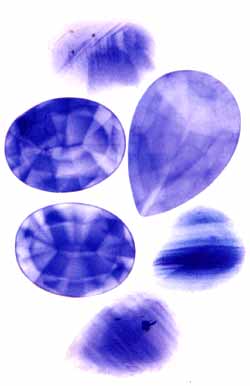 SSEF explained that to develop blue in Guada sapphire,a reducing
atmosphere is necessary. The reductive atmosphere in a furnace is
frequently obtained by burning fuel,thereby removing free oxygen.
A second method is to flood the furnace with a neutral gas,such
as nitrogen. According to SSEF , in the case of the Sri Lanka stones,the
second method was used." We were informed [by] the National
Gem & Jewelry Authority of Sri Lanka the electrical furnace
with protective gas were used for the heating of the stones which
proceeds
SSEF explained that to develop blue in Guada sapphire,a reducing
atmosphere is necessary. The reductive atmosphere in a furnace is
frequently obtained by burning fuel,thereby removing free oxygen.
A second method is to flood the furnace with a neutral gas,such
as nitrogen. According to SSEF , in the case of the Sri Lanka stones,the
second method was used." We were informed [by] the National
Gem & Jewelry Authority of Sri Lanka the electrical furnace
with protective gas were used for the heating of the stones which
proceeds
usually at 1800 Celcius," it wrote in its report. The Swiss
suggested that the colorless regions on the rim are result of a
technical oversight."Toward tyhe end of the heating process,
the pump for protective gas it stopped and some air (cotianing oxygen
) enter the furnace." This result in a minor degree of oxidtion,resulting
in the decolrization of surface related layer of the stone.
In the light of above explanation,SSEF said
that it would describe the stone it tested as"heated"
when issuing its laboratory test report. "We does not see the
evidence of diffusion of a foreign element, as in the case of the
beryllium treated orange and yellow
sapphires,"SSEF declared.
In the Gemological Institute of America's online
megazine, GIA Insider, GIA researchers Chistopher P. Smith and Matthew
Hall reported on thier visit to Sri Lanka,where they witnessed the
heat treatment of heat of blue sapphire by the same individual who
had developed the process under investigation. Smith and Hall evidently
had agreed beforehand not to reveal details about the heat-treatment,
they were permitted to examine the sapphire in question. Based on
thier observations and a detailed microscopic examination of the
sapphire after 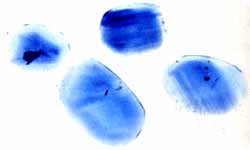 treatment,Smith
and Hall determined unequivocally that no synthetic sapphire growth
had taken place.Furthermore,the researchers did not witness the
use of fluxing agent during the heating experiment , and no evidenceof
flux was present on or around the sample brought back to the United
States for further analyses. Nonetheless,Smith and Hall preferred
to take a more equivocal approach." we can not state conclusively
the role that lattice diffusion plays in this peculiar color phenomenon
or which elements may be involved. However , we are continuing our
research onto the exact mechanisms responsible for this unusual
color concentrations, and will release our findings to the trade
as they become available." treatment,Smith
and Hall determined unequivocally that no synthetic sapphire growth
had taken place.Furthermore,the researchers did not witness the
use of fluxing agent during the heating experiment , and no evidenceof
flux was present on or around the sample brought back to the United
States for further analyses. Nonetheless,Smith and Hall preferred
to take a more equivocal approach." we can not state conclusively
the role that lattice diffusion plays in this peculiar color phenomenon
or which elements may be involved. However , we are continuing our
research onto the exact mechanisms responsible for this unusual
color concentrations, and will release our findings to the trade
as they become available."
 |

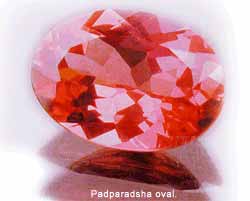 of South Africa ,is guaranteed to have completely natural color - it's
not even heated.
of South Africa ,is guaranteed to have completely natural color - it's
not even heated.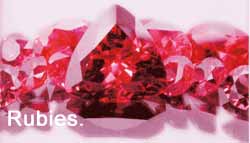



 SSEF explained that to develop blue in Guada sapphire,a reducing
atmosphere is necessary. The reductive atmosphere in a furnace is
frequently obtained by burning fuel,thereby removing free oxygen.
A second method is to flood the furnace with a neutral gas,such
as nitrogen. According to SSEF , in the case of the Sri Lanka stones,the
second method was used." We were informed [by] the National
Gem & Jewelry Authority of Sri Lanka the electrical furnace
with protective gas were used for the heating of the stones which
proceeds
SSEF explained that to develop blue in Guada sapphire,a reducing
atmosphere is necessary. The reductive atmosphere in a furnace is
frequently obtained by burning fuel,thereby removing free oxygen.
A second method is to flood the furnace with a neutral gas,such
as nitrogen. According to SSEF , in the case of the Sri Lanka stones,the
second method was used." We were informed [by] the National
Gem & Jewelry Authority of Sri Lanka the electrical furnace
with protective gas were used for the heating of the stones which
proceeds  treatment,Smith
and Hall determined unequivocally that no synthetic sapphire growth
had taken place.Furthermore,the researchers did not witness the
use of fluxing agent during the heating experiment , and no evidenceof
flux was present on or around the sample brought back to the United
States for further analyses. Nonetheless,Smith and Hall preferred
to take a more equivocal approach." we can not state conclusively
the role that lattice diffusion plays in this peculiar color phenomenon
or which elements may be involved. However , we are continuing our
research onto the exact mechanisms responsible for this unusual
color concentrations, and will release our findings to the trade
as they become available."
treatment,Smith
and Hall determined unequivocally that no synthetic sapphire growth
had taken place.Furthermore,the researchers did not witness the
use of fluxing agent during the heating experiment , and no evidenceof
flux was present on or around the sample brought back to the United
States for further analyses. Nonetheless,Smith and Hall preferred
to take a more equivocal approach." we can not state conclusively
the role that lattice diffusion plays in this peculiar color phenomenon
or which elements may be involved. However , we are continuing our
research onto the exact mechanisms responsible for this unusual
color concentrations, and will release our findings to the trade
as they become available." 